

Www.wildfoodschool.co.uk/urban/wfsURBANGUIDE.pdf. Foraging Guidelines. Foraging for wild food is a great way to experience the natural world and connect with something ancient and primal within ourselves.
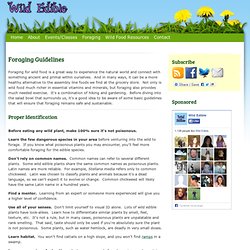
And in many ways, it can be a more healthy alternative to the assembly line foods we find at the grocery store. Not only is wild food much richer in essential vitamins and minerals, but foraging also provides much needed exercise. It's a combination of hiking and gardening. Before diving into the salad bowl that surrounds us, it's a good idea to be aware of some basic guidelines that will ensure that foraging remains safe and sustainable. Proper Identification Before eating any wild plant, make 100% sure it's not poisonous. Learn the few dangerous species in your area before venturing into the wild to forage. Don't rely on common names. Find a mentor. Use all of your senses. Learn habitat. How To Find & Enjoy Wild Foods. Lately I’ve been mining the Mother Earth News archive disks for bits of relevant wisdom—which are abundant there.

James E. Churchill’s advice on foraging and preparing wild foods from one of the earliest issues, September/October 1970, couldn't be more timely right now. Free food is abundant—and could be growing between the cracks in your sidewalk! Famine Food Homepage. By Bob Freedman 50 E.

Calle Encanto Tucson, Arizona 85710 ph. 520/977-4607 freedmanbob@yahoo.com The Famine Foods Database: Plants that are not normally considered as crops are consumed in times of famine. This botanical-humanistic subject has had little academic exposure, and provides insight to potential new food sources that ordinarily would not be considered. Notes on the Famine Foods Website by Robert L. Search the Famine Foods Database Plant family index. Fact Sheets. 50 Essential Wild Edible, Tea, and Medicinal Plants You Need to Know. I’ve been often asked in reference to a survival or bug-out situation “which wild edible and medicinal plants should I study and know?”.
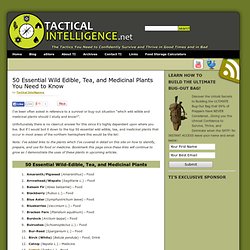
Unfortunately there is no clearcut answer for this since it’s highly dependent upon where you live. But if I would boil it down to the top 50 essential wild edible, tea, and medicinal plants that occur in most areas of the northern hemisphere this would be the list: Note: I’ve added links to the plants which I’ve covered in detail on this site on how to identify, prepare, and use for food or medicine. Bookmark this page since these links will continue to grow as I demonstrate the uses of these plants in upcoming articles.
Guide to Edible Wild Plants in North America. Foraging Guide - Edible Wild Plants of Temperate North America and the UK. Now FREE!!
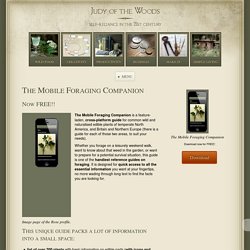
Image page of the Rose profile. The Mobile Foraging Companion is a feature-laden, cross-platform guide for common wild and naturalised edible plants of temperate North America, and Britain and Northern Europe (there is a guide for each of those two areas, to suit your needs). Whether you forage on a leisurely weekend walk, want to know about that weed in the garden, or want to prepare for a potential survival situation, this guide is one of the handiest reference guides on foraging. It is designed for quick access to all the essential information you want at your fingertips, no more wading through long text to find the facts you are looking for. This unique guide packs a lot of information into a small space: What is the difference between the N. There isn't a lot of difference, as most of the plants included grow throughout most of the temperate northern hemisphere.
Common names of plants vary, so each guide is written with the appropriate names for those countries. Advertising. Wildcrafting.net: Foraging Database, Edible & Medicinal Plants. Traditional Plant Foods Of Canadian Indigenous Peoples, Nutrition, Botany & Uses. Almost all major groups of wild plants in Canada have edible members that are reported to have been used by Indigenous People.
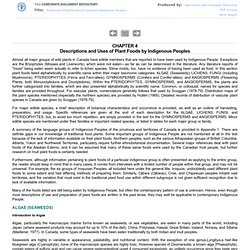
Exceptions are the Bryophytes (Mosses and Liverworts), which were not eaten—as far as can be determined in the literature. Any literature reports of "moss" being eaten seem actually to refer to lichen species. Slime molds, too, have no evidence of having been used as food. In this section plant foods listed alphabetically by scientific name within their major taxonomic categories: ALGAE (Seaweeds); LICHENS; FUNGI (including Mushrooms); PTERIDOPHYTES (Ferns and Fern-allies); GYMNOSPERMS (Conifers and Conifer-allies); and ANGIOSPERMS (Flowering Plants, both Monocotyledons and Dicotyledons). Within the PTERIDOPHYTES, GYMNOSPERMS, and ANGIOSPERMS, the plants are further categorized into families, which are also presented alphabetically by scientific name. Introduction to Algae Seaweeds are highly in variable in appearance, palatability, and nutritional content. Wild Food School - Foraging Data Sheets.
Edible Weed Datasheets - FREE Foraging for edible weeds is, for some folks, a way of life and a fun challenge.
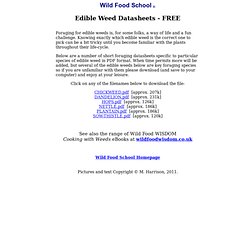
Knowing exactly which edible weed is the correct one to pick can be a bit tricky until you become familiar with the plants throughout their life-cycle. Below are a number of short foraging datasheets specific to particular species of edible weed in PDF format. When time permits more will be added, but several of the edible weeds below are key foraging species so if you are unfamiliar with them please download (and save to your computer) and enjoy at your leisure. Click on any of the filenames below to download the file: